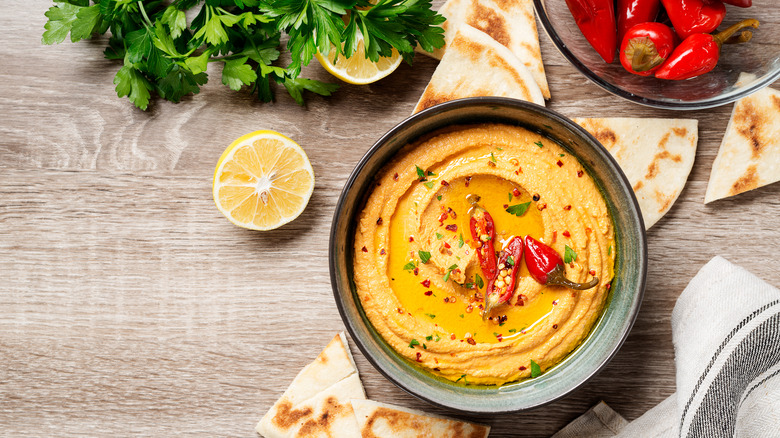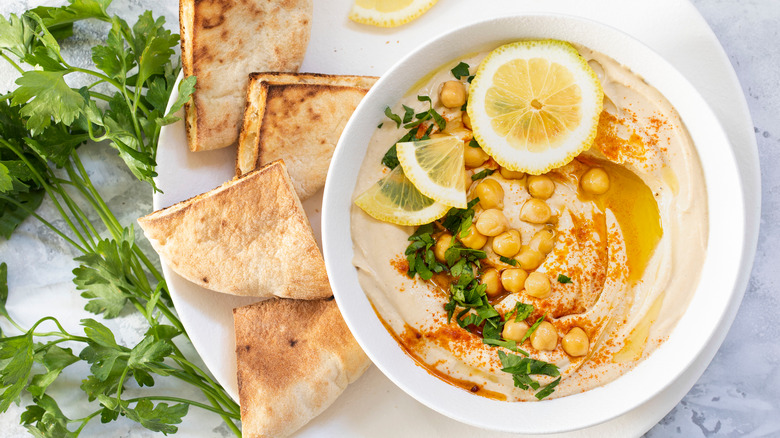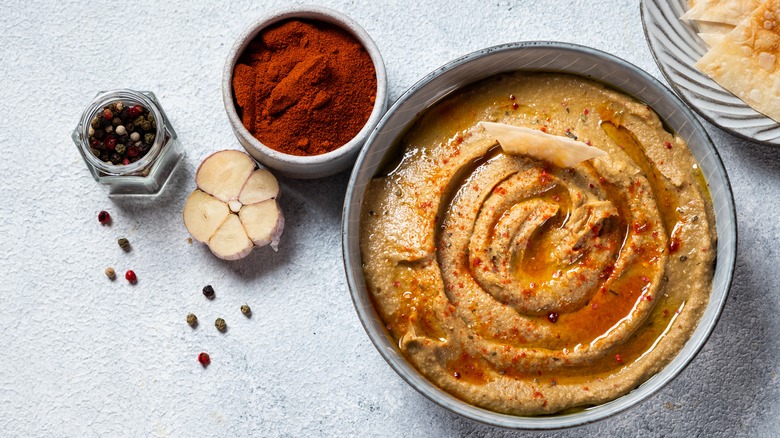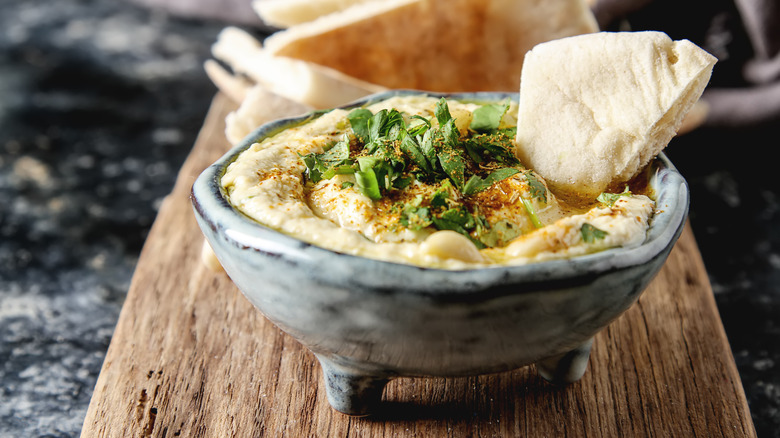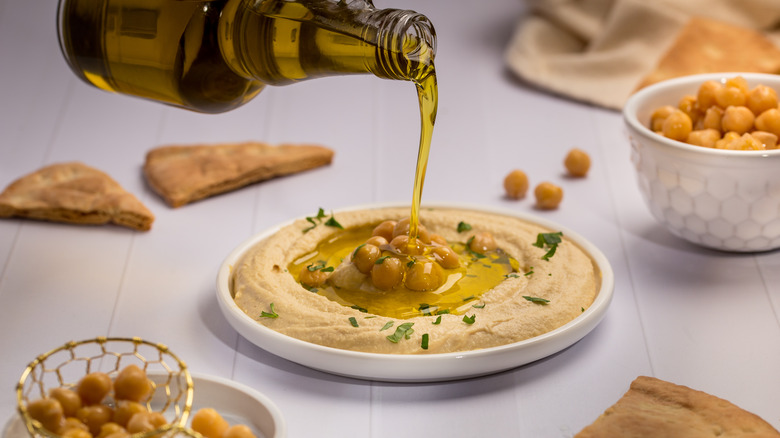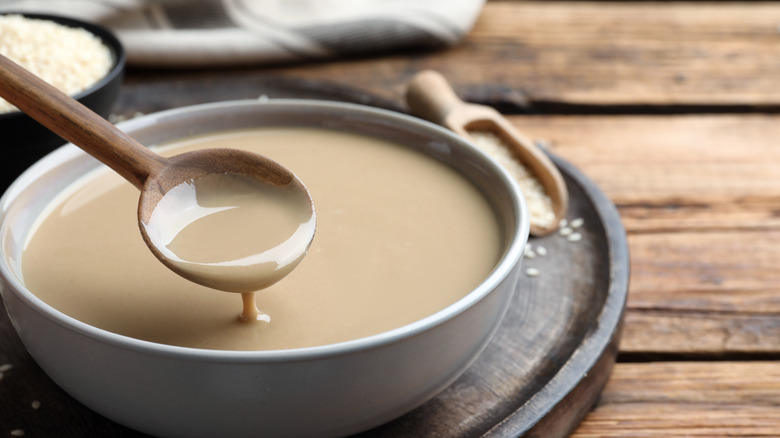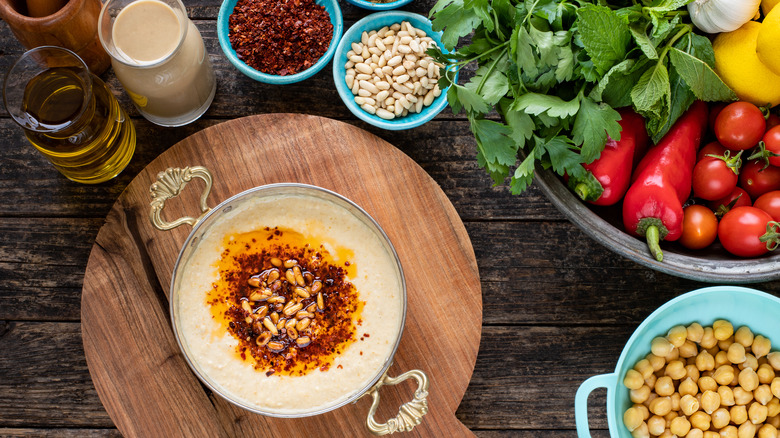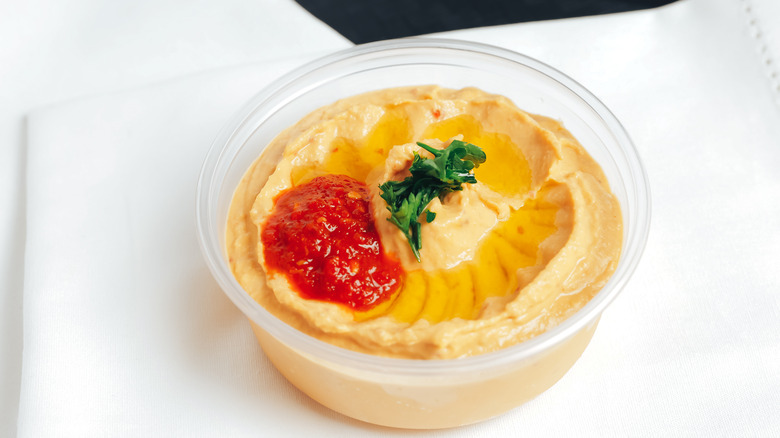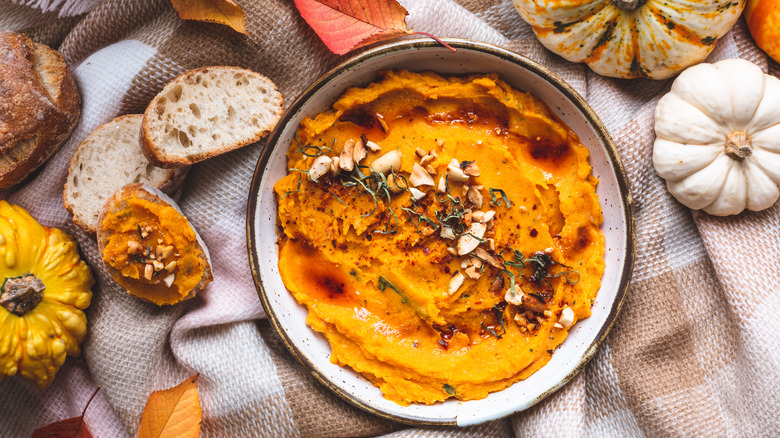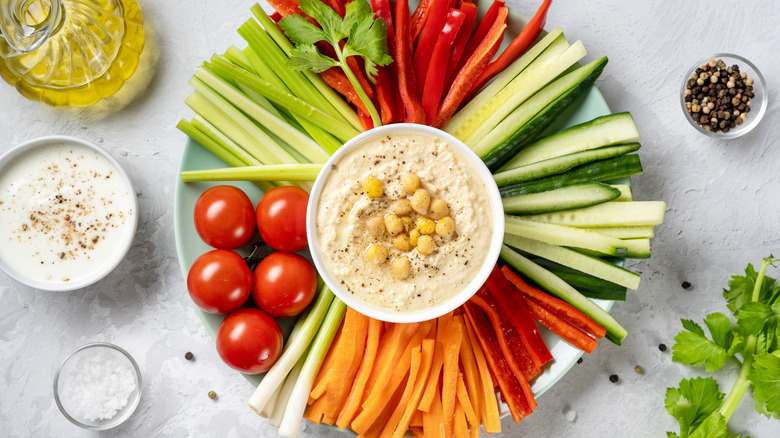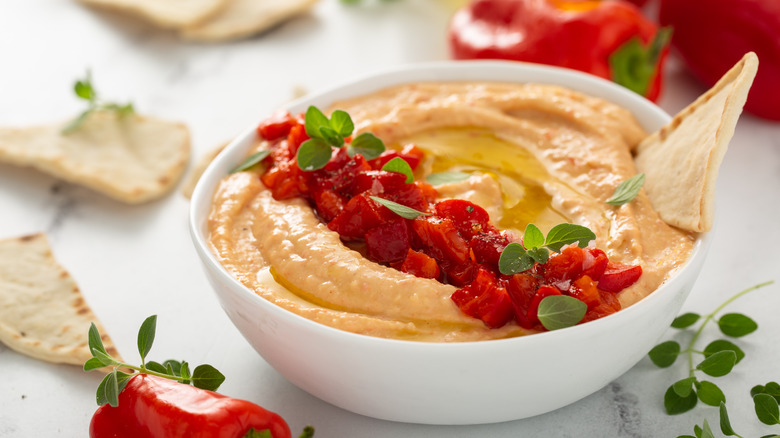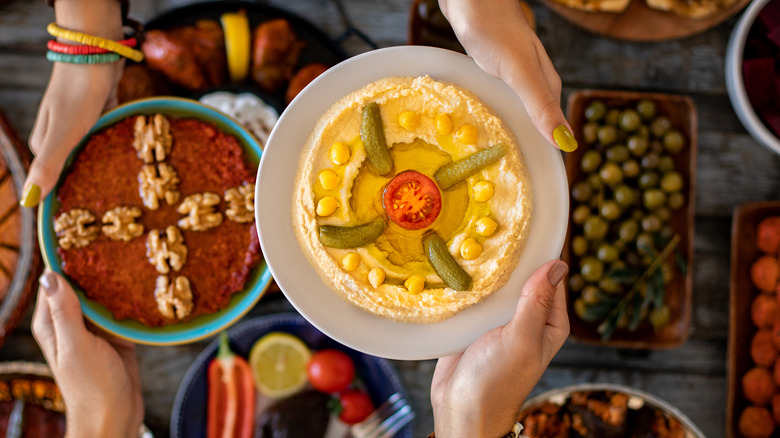Ingredients That Will Seriously Upgrade Store-Bought Hummus
Hummus is not an overly difficult dip to make at home — it usually only calls for chickpeas, tahini, garlic, lemon juice, and oil — but the convenience of grabbing a ready-to-eat pack from the store is just too difficult to resist. However, you already know that the pre-packed version will not be able to deliver the same quality as the one you make at home or the one that you get at your favorite Middle Eastern eatery. The usual problems relate to gritty texture and unbalanced flavors, but the most common issue is that the result is a mediocre, bland dip with no power or character.
Luckily for those who do not have the time to always whip up homemade versions, store-bought is an excellent alternative because you can tweak it and build up flavors and textures until you get a rendition that will meet your standards. We've listed the best ingredient upgrades to elevate store-bought hummus and turn it into a restaurant-quality dip. Most suggestions are convenient, uncomplicated, and do not call for obscure ingredients. They are easy to follow but leave much room for adaptation and creativity.
Apart from upgrading the ingredients, make sure to elevate the presentation game too. Throw away those unassuming plastic containers and spoon the hummus on an eye-catching plate. Any hummus boosted with these ingredients and served on a fancy plate is all set to become a centerpiece at the next dinner party.
Add lemon juice to brighten it up
Lemon juice is already a familiar savior in home kitchens that helps to brighten bland and tasteless dishes. It is also a regular ingredient in hummus, but if your store-bought version seems dull and one-dimensional, it may need a touch of extra lemon juice.
Chickpeas give hummus plenty of earthy and nutty qualities, but it's nice to add something fresh to liven it up. This role is usually assigned to lemon juice. Even the smallest amount can pierce through the creamy texture and help with the overall balance of flavors.
You can add lemon juice directly into the hummus and stir it in. It will have no problem blending into the mix, but if you want to highlight the tanginess, you can reserve a small amount of juice and drizzle it over the top. When adding lemon juice, it's always best to start light, taste, and gradually adjust. You don't want the potent sour notes and acidity to take over, as they should only complement chickpeas and tahini. Also, make sure to only use fresh lemon juice, as concentrates and syrups can't deliver the same quality of flavor.
Adjust seasonings and add more spices
Most store-bought hummus is sold plain, making it feel tedious, repetitive, and uninspiring. However, it also means that this creamy chickpea spread can act as a great blank canvas on which you can play with various additions to create a different version every time. The easiest way to do so is to look inside your spice cabinet.
Seasonings and spices are the best flavor boosters and will do wonders for your store-bought hummus. If you prefer heat, harissa spice mix is a great option, along with smoked paprika. These spices are not too fiery and go great with hummus. Even a light sprinkle will add an incredible depth of flavor. Sumac is another complex spice that will impart a subtly tangy flair and complement the dip's lemony notes. For more aromatics, crush some cumin or coriander seeds and sprinkle them on top. Essentially, think of store-bought hummus as a great way to show off your immense creativity with spices and blends.
Also, don't forget about salt. Taste the hummus, and if the flavors are too bland or out of balance, try adding a pinch of salt to help them pop. Don't sleep on pepper either. Even a whiff of freshly ground pepper will help your hummus gain a lot of character.
Add freshness with herbs
Though hummus gets some freshness from lemon juice, if you want to turn it up a notch and give your store-bought version more vigor and a stronger, zesty aroma, the best idea is to upgrade it with freshly chopped herbs.
There are no strict rules when it comes to the selection of the best herb and hummus pairings. This neutral dip is versatile and sturdy enough to take on many different flavors and aromas. If you are unsure about this idea, start with something light and not overly aromatic, such as fresh parsley. To dress it up in a Mediterranean style, add a handful of mint or fresh basil to impart that distinctive sweet and floral aroma. If you are a fan, cilantro's grassy character would also go well with earthy hummus, but make sure to replace lemon with lime in this combo. The easiest way to incorporate herbs is to sprinkle them on top of plated hummus, but you can also combine the hummus with the herbs and give them a few swirls in the blender until fully incorporated.
For a fancier version, make an herb sauce such as classic Italian gremolata or mix up an herb-infused oil and drizzle it on top of hummus. If you want an entirely hassle-free experience, look into the condiment section and repurpose herb-packed spreads and sauces, such as basil pesto, into fragrant hummus garnishes.
Olive oil is the secret for better texture and flavor
Store-bought hummus often has an unpalatable gritty texture that can be easily fixed with olive oil. Store-bought hummus can be made with or without olive oil, and this upgrade is especially good if olive oil is not listed in the ingredients. As you add the oil, vigorously mix the hummus — you want to emulsify it to create a smooth, uniform consistency.
Besides texture, olive oil can be a massive game-changer in flavor. Though not all olive oil is created equal, most examples have a strong character that infuses into the hummus and enhances its flavor and aroma. It often comes off as fruity, buttery, and pleasantly bitter, and it generally agrees with hummus. Make sure that the olive oil you are adding to the hummus is of the best quality. As it is not heated or masked with other ingredients, it will have enough room to show off all of its qualities, and you do not want an inadequate version to ruin the whole experience. Buy from trusted brands, and preferably, always go for extra virgin olive oil.
When it comes to olive oil, just like salt, it's better to add it gradually and taste as you go. You do not want to turn hummus into an olive oil dip or add too much and ruin the texture. You can drizzle the oil on top if you don't want to blend it into the hummus.
Build some character with more tahini
Tahini is a luscious, smooth sesame paste and one of the essential ingredients in classic hummus. It is added to improve texture and flavor. Tahini gives hummus a nice backbone and imparts a savory, nutty note. Sadly, many store-bought hummus varieties do not use enough tahini to make a difference and sometimes even totally leave it out. If you feel the dip is missing that distinctive oomph, blend in some tahini and you'll immediately notice significant improvement. Your hummus will gain a more serious and complex flavor profile.
This upgrade might not be the most convenient since tahini is not a common ingredient in home kitchens. However, it is readily available in stores, and it's really easy to whip up homemade tahini as it calls for only two ingredients. A jar of tahini will go a long way but don't limit its use to hummus. This wonderfully nutty paste makes an excellent spread and can be added to sauces, salad dressing, soups, and dips. It even makes a lovely addition to cakes and cookies.
Mix it up with nuts for some crunch
As hummus already possesses an inherent nutty quality, it generally agrees with various nuts. They deliver an additional flavor component but also upgrade the texture by adding bits of crunchiness that will be immensely fun to eat. It's best to chop the nuts roughly, and if you do not want to blend them in, they can just be sprinkled on top as a chunky garnish.
If you want to stay traditional, opt for pine nuts. These tiny nuggets are often associated with hummus and are commonly served with the dip. Pine nuts add a wonderful crunch to your store-bought hummus and deliver a subtly sweet, toasty flavor. But they can be pretty pricey — walnuts and hazelnuts are equally delicious but more affordable options. Walnuts impart a hearty, faintly bitter note, while hazelnuts add a more delicate, earthy quality. For the ultimate flavor bomb, sprinkle hummus with dukkah, a wonderful combination of nuts, seeds, spices, and herbs typically associated with Egyptian cuisine.
Regardless of the type of nuts or how they are incorporated, you should always lightly toast them first. Toasting will help release essential oils and make the nuts develop a deeper and more complex flavor and aroma.
Drizzle it with hot sauce
If you want to add an instant flavor boost to store-bought hummus, the best idea is to pair it with spicy hot sauces. The combination of creaminess and neutral flavor in classic hummus is the perfect playground for your favorite saucy condiments.
The best advice here is to go with your favorite hot sauce. Hummus is such a mellow dip that it can match virtually any spicy profile. Go classic with sriracha or Tabasco, but don't be afraid to experiment with fiery Mexican salsas or other regional variations such as piri-piri or flavor-packed Indonesian sambal. Korean gochujang paste is a great option to blend in the hummus, and it is a fantastic addition if you prefer the medley of sweetness and heat. When it comes to this spicy upgrade, there are no wrong answers, and even chili crisp will make store-bought hummus instantly better.
For more creative and adventurous alternatives, you can always make homemade hot sauces that you can tweak to your taste and enrich with garlic, aromatic spices, or herbs. If you have the time and patience, you can modify pre-made sauces with the same add-ons.
Mix in canned pumpkin
Pumpkin is an excellent addition to hummus as it delivers sweetness that perfectly complements all the earthy, nutty, and tangy flavors you will find in the standard version. It is subtle enough not to overwhelm the mix, but it will have no problem acting as a worthy partner in the blend and displaying its qualities. Pumpkin contributes to the texture, making the whole mix lighter, creamier, and more fluffy. The usually bland-colored hummus also gets a nice pop of orange color.
This is a great seasonal upgrade for the fall when many crave cozy pumpkin flavors. It would partner nicely with a touch of cinnamon that will give the dip a warmer and heartier character. Go one step further and spoon your pumpkin hummus on a plate and sprinkle it with toasted pumpkin seeds for a classy, crunchy touch.
Of course, adding canned pumpkin is the easiest route. Hummus and pumpkin puree have a similar consistency, so you don't have to pull out your food processor for this. Just use a spoon or whisk and mix until you get a smooth, creamy blend. If you have time and an extra pumpkin lying around, you can bake it, purée it, and then add it to the hummus mix.
Yogurt will make it less intense
For those rare moments when your store-bought hummus is overly robust and too intense, you can loosen it up with yogurt. This tangy dairy product can instantly lighten up the flavors and adjust the consistency of the dip. It can also be a nice replacement for lemon juice, as the two deliver similar zesty notes. You can choose various yogurt styles for this upgrade, but use only plain versions and skip sugary or flavored yogurts.
Due to its creamy texture and higher fat percentage, Greek-style yogurt is perhaps the best option to add to pre-packed hummus. However, regular, plain yogurt will also perform well. Just make sure to go with full-fat versions. They are far superior in flavor and have the ideal, smooth consistency that will significantly upgrade the texture of your hummus, turning it into an airy, cloud-like dip. Make sure to always add the yogurt gradually and mix well. Too much can leave you with a bland and watered-down hummus.
Yogurt can be folded in the hummus, especially if you want to use it to tweak the texture, but you can also use it as a garnish and drizzle it on top of a plated dish. Even the smallest amount will help hummus to attain a much livelier and brighter profile.
Be creative with veggies
The best way to show off your creativity with store-bought hummus is in partnership with vegetables. There are endless possibilities and no restrictions in this combination. Green leafy veggies, earthy roots, pods, buds — all kinds of juicy summer produce are all suitable picks. Veggies will boost color, flavor, and texture and are generally a great way to incorporate more wholesome options into your diet.
The easiest veggie hummus upgrade is to slice up some veggies and serve them on top. If you want to pack the hummus with brightness and freshness, turn the veggies into a salad — use Greek salad as an inspiration — and just spoon it over the hummus. Feel free to play with size, textures, seasonings, and combinations, and if veggies require processing, consider a short sauté — ideally in olive oil — that will soften them up and enhance the flavors. Grilling and roasting are great alternative techniques to give the veggies some char and smokiness.
The best way to dress up hummus with veggies is to use your fridge as an inspiration. Alternatively, you can rely on hummus as a great vessel to use up all the veggies sitting in the fridge for too long. Healthy, creative, adaptable, and delicious, this is perhaps the ideal upgrade for your pre-packed hummus.
Don't forget pickled products
Pickles and fermented foods are everyday staples in home kitchens that make our daily lives easier and more flavorful, but they often don't get the credit they deserve. Their long shelf life and incredible creative potential are simply not promoted enough. Among the many creative ways you can use them up, garnishing your store-bought hummus with pickled produce probably tops the list.
Start with the classics. Thinly sliced pickles will go great with hummus and can add an interesting herbaceous note. Pickled peppers are another favorite. Jalapeños are a foolproof option, but feel free to play with other choices to vary the amount of heat and tang you want to incorporate. Pickled onions, radishes, carrots, cauliflower, or beets all make attractive partners with hummus. Olives are also an excellent addition that you can serve whole or slice up for easier scooping. Apart from classic pickled produce, don't skip the chance to make creative fusion combos. Spice-laden kimchi would be a very exciting hummus garnish; so would the thin strips of zesty pickled ginger. Think outside the box, and don't be afraid to experiment with pickled and fermented fruits that can add a nice semi-sweet and tangy note to your store-bought hummus.
